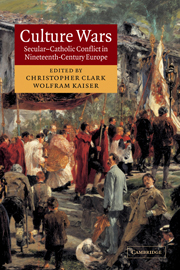Book contents
- Frontmatter
- Contents
- List of illustrations
- List of contributors
- Introduction: The European culture wars
- 1 The New Catholicism and the European culture wars
- 2 ‘Clericalism – that is our enemy!’: European anticlericalism and the culture wars
- 3 ‘Priest hits girl’: on the front line in the ‘war of the two Frances’
- 4 The battle for monasteries, cemeteries and schools: Belgium
- 5 Contested rituals and the battle for public space: the Netherlands
- 6 Nonconformity, clericalism and ‘Englishness’: the United Kingdom
- 7 The assault on the city of the Levites: Spain
- 8 Roma o morte: culture wars in Italy
- 9 Enemies at the gate: the Moabit Klostersturm and the Kulturkampf: Germany
- 10 Village quarrels and national controversies: Switzerland
- 11 The Counter-Reformation's last stand: Austria
- 12 The uncivil origins of civil marriage: Hungary
- Annotated bibliography
- Index
12 - The uncivil origins of civil marriage: Hungary
Published online by Cambridge University Press: 23 July 2009
- Frontmatter
- Contents
- List of illustrations
- List of contributors
- Introduction: The European culture wars
- 1 The New Catholicism and the European culture wars
- 2 ‘Clericalism – that is our enemy!’: European anticlericalism and the culture wars
- 3 ‘Priest hits girl’: on the front line in the ‘war of the two Frances’
- 4 The battle for monasteries, cemeteries and schools: Belgium
- 5 Contested rituals and the battle for public space: the Netherlands
- 6 Nonconformity, clericalism and ‘Englishness’: the United Kingdom
- 7 The assault on the city of the Levites: Spain
- 8 Roma o morte: culture wars in Italy
- 9 Enemies at the gate: the Moabit Klostersturm and the Kulturkampf: Germany
- 10 Village quarrels and national controversies: Switzerland
- 11 The Counter-Reformation's last stand: Austria
- 12 The uncivil origins of civil marriage: Hungary
- Annotated bibliography
- Index
Summary
And so, if it is there that he is lying, quiet sleeps Count Buttler of Párdány. It is a good place to sleep, that peaceful vault at Dobóruszka. There is a stillness all around. Even in the forests there is no more singing; for the forests are gone. Only from the nearby swamps there is sometimes heard the croaking of the frogs: ‘Clerics are crooked! Clerics are crooked!’
So ends Kálmán Mikszáth's Strange Marriage, which appeared in 1900. In the novel, the unscrupulous Baron Dőry, in order to avoid a scandal, forces the young Count Buttler to marry his pregnant daughter. The young woman is carrying the child of the local priest, who, to make matters worse, also turns out to be an ardent Slovak patriot. Though Mikszáth set the story in the early nineteenth century, its anticlericalism is more a reflection of the bitter church–state struggles that dominated Hungarian political life in the 1890s. Tensions had long existed between the Catholic church and the state, and they intensified following the Ausgleich of 1867 and the subsequent rise to power of the Liberal Party, which governed Hungary uninterruptedly from 1875 to 1905. The spark came in 1890, when the minister of religion and public education, Count Albin Csáky, issued an ordinance calling for administrative enforcement of existing laws concerning the children of mixed marriages, thereby threatening non-compliant Catholic priests with fines and prison sentences.
- Type
- Chapter
- Information
- Culture WarsSecular-Catholic Conflict in Nineteenth-Century Europe, pp. 313 - 335Publisher: Cambridge University PressPrint publication year: 2003
- 3
- Cited by

